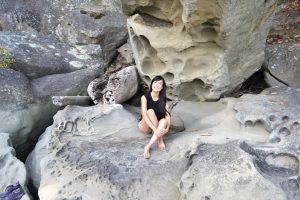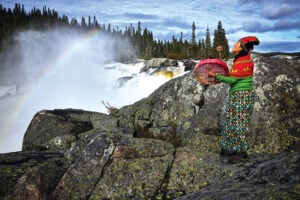
People & Culture
Kahkiihtwaam ee-pee-kiiweehtataahk: Bringing it back home again
The story of how a critically endangered Indigenous language can be saved
- 6310 words
- 26 minutes
This article is over 5 years old and may contain outdated information.
People & Culture

He’s been called the Indiana Jones of Entomology. His passion? The insect that makes up an estimated 15 to 25 per cent of all terrestrial animal biomass: ants.
Award-winning photographer Mark Moffett combines science and photojournalism to give viewers a unique glimpse into the world of ants. His macro shots are featured in the Smithsonian’s exhibit Farmers, Warriors, Builders: The Hidden Life of Ants on now at the Canadian Museum of Nature.
Canadian Geographic got in touch with Moffett, author of Adventure Among Ants, to learn what he thinks makes great wildlife photography.
Canadian Geographic: What appeals to you about photographing ants in particular?
Mark Moffett: One advantage of ants is that I don’t feel too many qualms about smashing one at the end of the day or putting one in alcohol for research, whereas, if they were pandas, I would feel really bad about that. If you’re down on your knees photographing ants and you accidentally squish one, it’s actually just fine so long as she’s not the queen. So there’s less guilt, but there’s also just so much going on. Ants are really a lot like us. There’s always a hive of activity with everyone building, making infrastructure for roads, hunting for food together. All kinds of things happen in a coordinated way just like they happen for humans. There’s a sense that things are going on constantly, which actually makes it easier to photograph ants because there’s never a dull moment.
Can Geo: Ants can have very painful stings. How do you get up close?
MM: I have a high pain threshold. Once I get something in front of me, I forget where I am, and I just kind of go into this world with my subject, which I think is important when you’re photographing anything including people. I don’t mind stings and bites. If you’re going to love anything in the world, you have to put up with the other side of it, whether it’s a person or an animal. If you don’t do that, you don’t really love it, you’re just taking advantage of it. However, I do not hang out a lot with the worst stinging ants. I prefer to avoid the most painful of them.

Can Geo: How much time do you spend around ants?
MM: Well, we all spend virtually all of our time around ants. But in terms of when I’m actually looking for ants, it all depends. I’m not just a photographer and writer; I also do studies on ants. I’ve spent the last few months doing research involving reading lots of books and not a lot of time in nature. And then I’ll immerse myself for a month ands ants will be just so pervasive that when I fall asleep, instead of sheep, I see a clump of ants walking across my eyes, like a highway going by. I don’t know if that would put many people asleep.
Can Geo: You are an entomologist and did a doctorate on ants. How does that knowledge influence your approach to your photography?
MM: Most scientists are actually terrible photographers, which doesn’t make sense to me. Science is like the journalism of nature and journalists are supposed to be good at conveying things. You should be able to tell stories with science. For me, if I’m going to tell a story with science, it has to be exciting and engaging.

Can Geo: What do you do that is different from other nature photographers?
MM: There are some really great nature photographers out there, but the problem with nature photography is that it’s well behind any other kind of journalism. It’s often calendar-like pictures all over the place with lots of colour and the cutest thing sitting there looking at you. There’s just so much more you can do to get into the behaviour and life of things. What are the central things for its life? What are the pivotal turning points? How can you convey those in a strong way?
For the last few years, there’s been this trend of going back to these old-time life pictures from the ‘70s, where photographers put animals on these white backgrounds and photograph them in a lab. But they’re taking animals out of context. The real challenge is to show the animal’s place in the world.
You know, even the common housefly would make a great article if someone could figure out how to follow it around. The small and mundane can be a great story if you do it right. In fact, that’s the challenge for me: I like to get people excited about unexpected things. It’s all very well to have a magazine cover of a panda, but it’s not really much of a challenge compared to making people fall in love with things they don’t expect.

Can Geo: What do you think everyone should know about ants?
MM: Humans may be more closely related to chimpanzees, but modern humans are really more like certain kinds of ants than we are like chimpanzees, because we have to worry about things like highways, traffic rules, infrastructure, market economy issues, public health, safety issues and all kinds of things that arise because you have hundreds of thousands or millions living together. Ants spend a lot of time dealing with things like garbage and disease and making sure the nest is clean. Chimpanzees don’t have to deal with any of those things. But ants do. It’s kind of an interesting parallel to humans. As a society, they’ve had to work out a lot of these things otherwise the whole thing would collapse. And it’s the same with humans.
Visit the Canadian Museum of Nature’s website to learn more about the exhibit Farmers, Warriors, Builders: The Hidden Life of Ants.


Are you passionate about Canadian geography?
You can support Canadian Geographic in 3 ways:

People & Culture
The story of how a critically endangered Indigenous language can be saved

People & Culture
The family physician advocates for outdoor time with the PaRx nature prescription program

Wildlife
Wildlife photographers on the thrill of the chase — and the importance of setting ethical guidelines

Environment
In February 2021, the world was introduced to Mutehekau Shipu — also known as the Magpie River — when the people of Ekuanitshit, Que. and the regional municipality made a joint declaration granting the river legal personhood and rights. The declaration carries broad implications for the fight to protect nature across Canada and around the world.